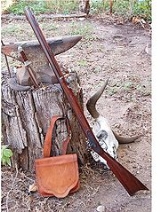
Hawken rifle
Overview
Gunpowder
Gunpowder, also known since in the late 19th century as black powder, was the first chemical explosive and the only one known until the mid 1800s. It is a mixture of sulfur, charcoal, and potassium nitrate - with the sulfur and charcoal acting as fuels, while the saltpeter works as an oxidizer...
long rifle
Long rifle
The American longrifle , better known as the Kentucky rifle was described best by Captain John G. W. Dillin in the dedication to his seminal 1924 book, The Kentucky Rifle:...
used on the prairies and in the Rocky Mountains of the United States during the early frontier days. It has become synonymous with the "plains rifle", the buffalo gun, and the fur trapper's gun. Developed in the 1820s, it was eventually displaced by breechloaders (such as the Sharps rifle
Sharps Rifle
Sharps rifles were those of a series begun with a design by Christian Sharps. Sharps rifles were renowned for long range and high accuracy in their day.-History:Sharps's initial rifle was patented September 17, 1848 and manufactured by A. S...
) and lever-action
Lever-action
Lever-action is a type of firearm action which uses a lever located around the trigger guard area, to load fresh cartridges into the chamber of the barrel when the lever is worked. Most lever-action firearms are rifles, but lever-action shotguns and a few pistols have also been made...
rifles which flourished after the Civil War.
The Hawken "plains rifle" was made by Jacob and Samuel Hawken
Jacob and Samuel Hawken
Jacob and Samuel Hawken were American gunsmiths and traders that operated from their shop in St. Louis, Missouri from 1825 to 1855. They are famous for designing the famous "plains rifle" named after them .-History:...
, or by their St. Louis, Missouri
St. Louis, Missouri
St. Louis is an independent city on the eastern border of Missouri, United States. With a population of 319,294, it was the 58th-largest U.S. city at the 2010 U.S. Census. The Greater St...
shop, which they ran from 1815 to 1858.

